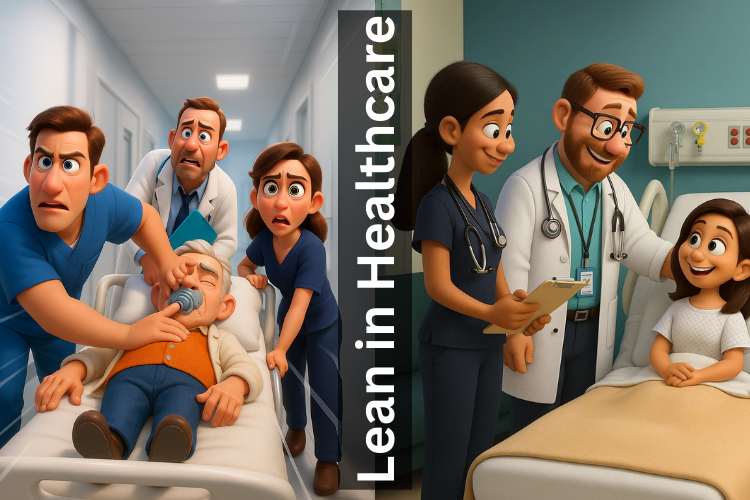When most people hear the word lean, their minds go straight to manufacturing floors—assembly lines, efficiency charts, and machines humming in sync. But lean thinking isn’t exclusive to factories. It’s a framework for problem-solving and process improvement. Know more about this with KKBooks.
And one industry that could benefit from it the most is healthcare.
In hospitals, clinics, and primary care centers, every delay comes with a cost. A few minutes waiting for a patient file. A long queue outside the emergency room. An exhausted nurse who misses a step during shift change. These aren’t just inefficiencies—they affect patient outcomes and the well-being of the healthcare workforce.
So, what happens when we apply lean thinking here?
Why Lean in Healthcare?
Lean isn’t about doing more with less. It’s about identifying what adds value and removing what doesn’t—whether that’s excess paperwork, duplicate processes, or unclear communication.
In healthcare, this translates to:
- Faster diagnosis and treatment times
- Shorter patient waiting periods
- Smoother coordination between departments
- Less burden on administrative and clinical staff
While machines on a factory floor won’t burn out, people do. And that’s where lean has a unique role in healthcare: it not only improves systems but protects the people working within them.
The Burnout Crisis
Doctors, nurses, and support staff are the backbone of the healthcare system. But many work under intense pressure. Long hours, unpredictable schedules, and emotional demands lead to one clear result: burnout.
According to a study by the Indian Journal of Psychiatry (2022), over 40% of Indian healthcare workers reported burnout symptoms. This includes fatigue, depersonalization (feeling detached from one’s work), and a reduced sense of accomplishment.
Burnout isn’t just a personal issue—it impacts teamwork, increases the risk of medical errors, and lowers patient satisfaction.
Lean in Action from a Tamil Nadu Hospital
Let’s look at how a medium-sized hospital in Tamil Nadu handled rising burnout rates using lean principles.
The Problem:
Staff at the emergency department were struggling. Patients would arrive at unpredictable hours, and the triage process often got bottlenecked. Nurses had to juggle paperwork, patient monitoring, and interdepartmental calls. On many days, they skipped breaks, and shift-end documentation often dragged on for 1–2 hours beyond their scheduled time.
Step 1: Mapping the Process
The hospital brought in a lean consultant team. The first thing they did was shadow the workflow. They created a value stream map: every step from ambulance arrival to doctor diagnosis was documented.
What they found:
- Nurses were spending 30% of their time on non-clinical documentation
- Equipment was not standardized—gloves and syringes were kept in different drawers in each room
- Lab requests often got delayed due to unclear handoffs
Step 2: Removing Waste
Lean doesn’t mean cutting jobs—it means cutting steps that don’t add value.
Here’s what changed:
- Shifted to electronic triage forms with dropdown options to reduce data entry time
- Introduced standardized emergency trolleys with labeled drawers across all rooms
- Created a “fast track” system for patients with minor injuries, reducing crowding
Step 3: Visual Communication
A simple digital dashboard was added in the ER. It showed:
- Patients currently waiting
- Priority level
- Assigned staff
- Lab test status
This gave all team members a shared view and reduced the number of verbal check-ins required.
Step 4: Staff Scheduling and Breaks
Breaks were scheduled systematically into shifts, and a cross-coverage system was introduced. If Nurse A were on break, Nurse B would temporarily monitor her patients. This was planned, tracked, and respected.
The Result
Six months after implementation:
- Time to triage dropped by 40%
- Patient satisfaction scores improved
- Most importantly, the average overtime for ER nurses fell from 90 minutes/day to 20 minutes/day
- Staff reported feeling more in control and less drained
One nurse shared in feedback, “I no longer feel like I’m racing all day. There’s a structure now. I can focus on patient care.”
Key Takeaways
Lean isn’t a factory-only idea. In healthcare, it does more than just speed up a process—it brings clarity, structure, and relief to the people working under pressure.
By reducing repetitive tasks, clarifying roles, and introducing standardization, healthcare teams:
- Save time
- Make fewer errors
- Get more time for patient interaction
- Experience fewer symptoms of burnout
And none of this requires massive investments. Most lean changes are small, common-sense steps based on observation and involvement of frontline workers.
Final Thoughts
The ambulance doesn’t stop at the hospital gate. The entire patient experience—from entry to exit—is made up of touchpoints that can be improved. Each second matters. And so does the well-being of those delivering care.
If lean thinking can help hospitals become calmer, safer, and more efficient, isn’t it time we stop thinking of it as just a factory tool?
Let us know your thoughts in the comment section, and also what other industry lean is best suited for. Comment Below.


1 Comment
Who knew mapping trolleys could be a game-changer? Lean in healthcare makes so much sense – its like giving overwhelmed nurses a superpower to fight burnout! Those visual dashboards and scheduled breaks are pure genius. Honestly, if saving 70 minutes of overtime and making nurses feel less like theyre racing all day isnt lean at its finest, I dont know what is. Definitely proving lean isnt just for factories; its a life-saver for busy ERs!